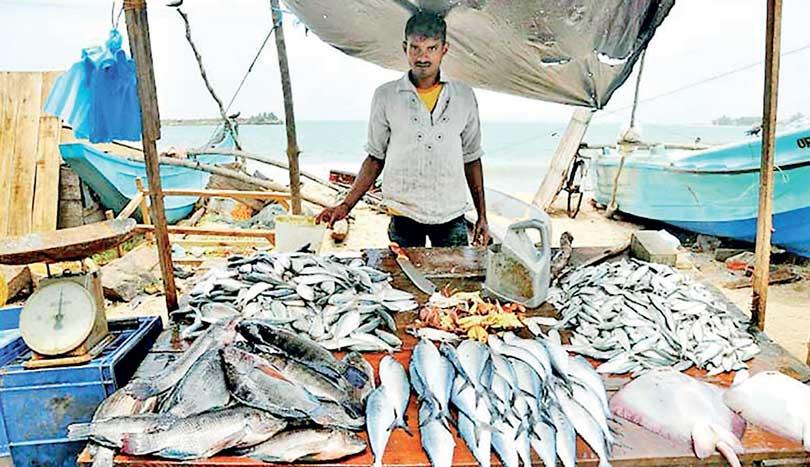18 Jan 2024 - {{hitsCtrl.values.hits}}

The management of fisheries resources is fundamental to ensure food security of the country
The FAO also highlights that the fisheries sector in Sri Lanka faces various challenges, including overfishing, illegal, unreported, and unregulated (IUU) fishing, and declining fish stocks. The FAO says climate change and its impacts on the marine environment also pose threats to the sustainability of fisheries
Quality is lost because of the lack of cooling or refrigeration facilities in fishing vessels. Dr. Palitha Kithsiri says, the quality of fish could be assured at the highest level at landing sites, if such facilities were made available. “Quality loss is as high as 80 percent in the southern part of Sri Lanka. When fish is graded lower, it will be used only for dry fish production, as it is not suitable for a normal seafood market,” he said in a discussion with Daily Mirror
 When you stroll through your seafood market, you find the ocean’s bounty laid out in stalls in front of you. But, have you ever paused to ponder whether the quality of fish you bring home holds the distinguished mark of the highest grade? The answer is probably “no”.
When you stroll through your seafood market, you find the ocean’s bounty laid out in stalls in front of you. But, have you ever paused to ponder whether the quality of fish you bring home holds the distinguished mark of the highest grade? The answer is probably “no”.
The fishing industry plays a key role in Sri Lanka’s social and economic life, and consists of three main sub sectors - coastal, offshore or deep sea, and inland or aquaculture.
According to the Food and Agriculture Organization (FAO) of the UN, the sector contributes significantly to the economic development of Sri Lanka by providing livelihoods to more than 2.5 million coastal communities. In its latest research paper, the FAO outlines that fish make up about 50 percent of Sri Lankans’ animal protein intake, a ratio three times the global average.
Today, the sector is suffering a double-whammy. One is the impact triggered by climate change and the other, the post-harvest quality loss from the poor handling of fish. In fact, 40–60 percent quality loss is reported in Sri Lanka, according to the FAO’s Fisheries Specialist for Sri Lanka and the Maldives, Dr. H. M. Palitha Kithsiri. Once harvested, fish is graded as A, B, C or D in terms of quality, determined according to thickness, odour, Histamine level etc.
However, quality is lost because of the lack of cooling or refrigeration facilities in fishing vessels. Dr. Kithsiri said the quality of fish could be assured at the highest level at landing sites, if such facilities were made available.
“Quality loss is as high as 80 percent in the southern part of Sri Lanka. When fish is graded lower, it will be used only for dry fish production, as it is not suitable for a normal seafood market,” he said in a discussion with Daily Mirror.
As a solution, the FAO is proposing the improvement of facilities in multi-day fishing vessels. Once harvested, fish stocks are stored using ice or ice packs, in holding facilities
in vessels.
“In multi-day vessels, fish stocks are stored for four to eight weeks. But ice starts melting after about one week. To address this issue, as a pilot project, the FAO has introduced economically viable refrigeration facilities. We are now checking the fish quality. We will get the reports soon,” he said.
Now, the FAO is introducing this advanced cooling system, particularly for the benefit of long-line fishermen who catch yellow-fin tuna for the export market.
Poor handling is another issue leading to the quality drop.
The management of fisheries resources is fundamental to ensure food security of the country. Sri Lanka is currently practicing aquaculture farming, especially for Penaeus monodon, Vannamei shrimp and crabs. These are good income generating sources to the industry, which will help improve fishing stock status and market recognition.
In the research paper, the FAO also highlights that the fisheries sector in Sri Lanka faces various challenges, including overfishing, illegal, unreported, and unregulated (IUU) fishing, and declining fish stocks.
The FAO says climate change and its impacts on the marine environment also pose threats to the sustainability of fisheries.
“An important part of the fish stocks that Sri Lankan fishers harvest is degraded, and catches are declining. When managed in an environmentally, socially and financially sustainable manner, fisheries, including coastal and aquaculture, hold significant promise for increased export earnings and skilled jobs. Actions need to be taken to minimize post-harvest losses to assure harvested product quantity and quality,” the
FAO says.
Despite Sri Lanka being an island with the potential for a blue economy, Sri Lanka is one of the main fish and fishery products importing countries in South Asia, especially due to the inadequate domestic production of dried fish and sprats.
According to the FAO, the development of fisheries affiliated industries - upstream and downstream - is crucial and has direct impacts on the sustainable development of the fisheries industry in the country.
In this case, producing inputs - production related and infrastructure related inputs - is the key. Fishing crafts or boats, fishing gear and ice are major production-related inputs, while harbours, anchorages and landing centres are infrastructure-related inputs.
Both women and men play different roles in the fishing sector, although geographical and ethnic variations exist, according to the FAO.
Fish harvesting is predominantly done by men. Women engage in ‘gleaning’ or harvesting fish, prawns, crabs, clams and mussels in coastal waters. Women also mainly perform post-harvest activities, notably drying.
The FAO along with the government and other stakeholders has implemented strategies and initiatives to contribute to the sustainable use and conservation of fisheries resources, while ensuring food and nutritional security in the country.
It is providing technical support to improve hatchery skills for quality seed production through good practices, better management and upgrading the hatchery facilities recently established by NAQDA (National Aquaculture Development Authority)
Adaptation to climate change is yet another challenge the FAO is now promoting, to ensure the sustainability of the industry.
The FAO says climate change affects fish and their habitats. Warmer temperatures influence the abundance, migratory patterns and mortality rates of wild fish stocks, and determine what species can be farmed in certain regions.
“These climatic effects on fish will have social and economic consequences for people dependent on fisheries and aquaculture - from workers to coastal communities to consumers of fish,” the FAO says.
Fishing vessel design adaptation to climate change, increasing fuel efficiency on multi-day vessels and establishing and improving safety measures for the fishery sector are among project activities being undertaken by the FAO.
In navigating the complexities of Sri Lanka’s fishing industry, a harmonious blend of innovation, sustainability and gender-inclusive practices emerges as the beacon of hope. As the nation grapples with these challenges, a concerted effort is underway to ensure that the bounty of the ocean continues to enrich lives and livelihoods for generations to come.
25 Nov 2024 5 minute ago
25 Nov 2024 23 minute ago
25 Nov 2024 48 minute ago
25 Nov 2024 1 hours ago
25 Nov 2024 1 hours ago